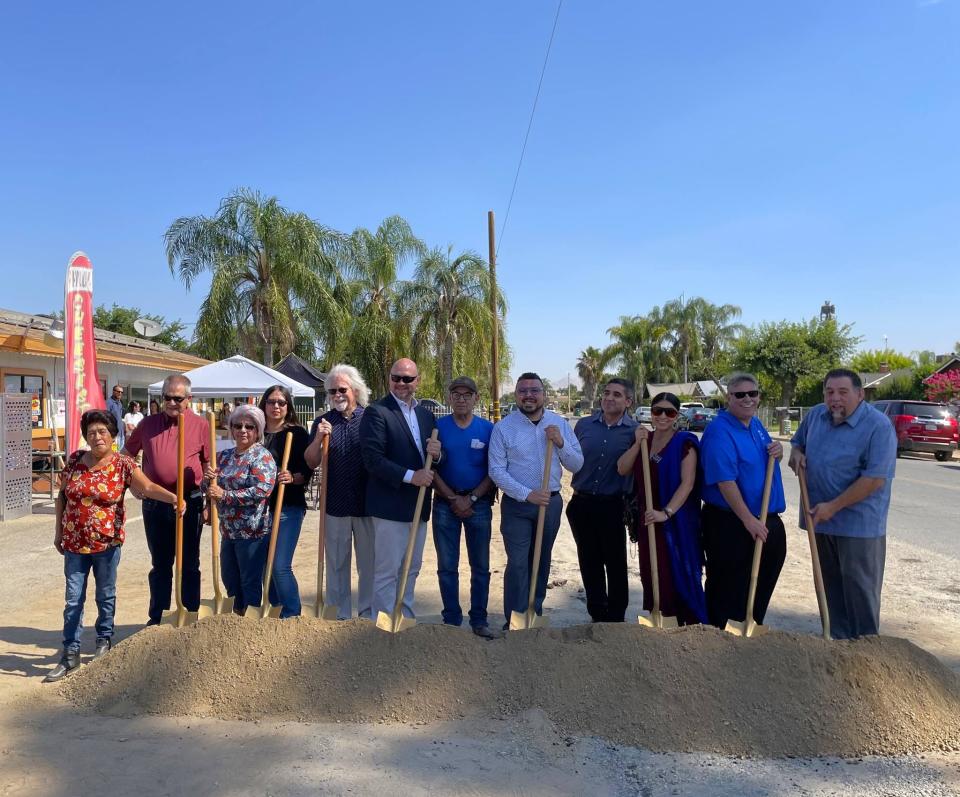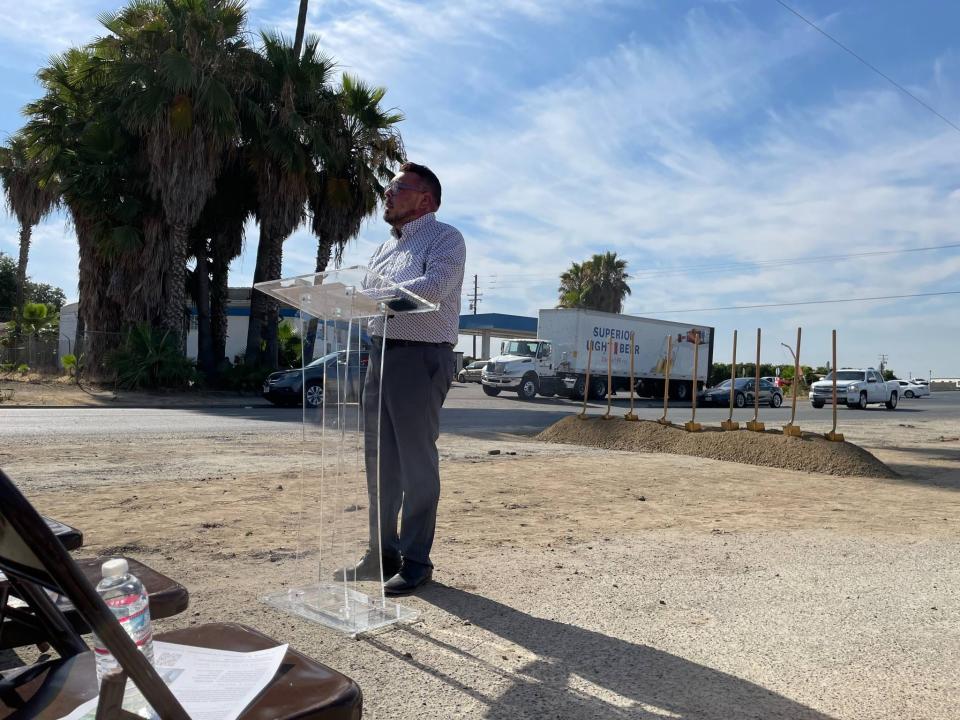Road 160 Sidewalk Improvement Project in Ivanhoe finally begins
The Road 160 Sidewalk Improvement Project in Ivanhoe has started.
Construction signs went up in late June and demolition, the first step in the construction, will start on July 1.
In addition to sidewalks, the project, approved by the Tulare County Board of Supervisors in 2019, includes the installation of 19 ADA-compliant curb ramps, an ADA-compliant Tulare County Regional Transit Agency bus stop, and high visibility crosswalks at the intersections of Road 160 and Heather, and Road 160 and Avenue 332.
Improvements will also include curbs, gutters, driveway approaches, asphalt paveouts, and drainage improvements along Road 160, considered to be the main artery into Ivanhoe.
“Our goal is to have it done by August,” said Hernan Beltran, Tulare County Resource Management Agency (RMA) chief engineer. “The improvements will start on the east side of Road 160, beginning at State Route 216 and progressing north.”

Connecting a community
The project was funded by a $1.3 million grant from Caltrans’ Active Transportation Program (ATP) awarded through the Tulare County Association of Governments (TCAG), along with another $1.3 million from Tulare County.
ATP grants come from state and federal funds by way of the California Transportation Commission. The goal of the ATP program is to encourage more active types of transportation, such as walking and biking, as well as increasing the safety and mobility of non-motorized users.
“I’m excited about this project,” said Tulare County Supervisor Eddie Valero, whose district includes Ivanhoe.
“It all goes back to community voice, community impact, community collectively coming together to identify and understand the need,” he said. “There were passionate residents who were committed, connected, and really concerned about their community, and they worked with their leaders to make sure that we keep our community safe.”
Soon after becoming a supervisor in 2019, Valero held a series of meetings in Ivanhoe to hear the community’s needs and concerns.
“Several items came to the forefront, i.e. the sidewalk crossing on 328, the turning lanes on the same road because cars fly through there on their way entering Ivanhoe,” he said. “This is just another example of a project we’re committed to for that particular community.”
The county’s Road 160 project helped move up the planned Caltrans project for Ivanhoe that was not scheduled to start until 2027, according to Valero. That project, which he said Caltrans officials told him they would now begin in 2025, will include sidewalks in front of Valley Foods Market and the Klink Citrus Association building.
“When partner agencies see that work is getting done, they want to complement it, as opposed to letting it linger,” explained Valero. He added that other agencies often have the attitude that, “If there’s already great work happening, let’s add to the great work by complementing the project and moving it forward to full completion.”
Safety for young students
The project is expected to add a layer of safety for students as they travel to and from school, Ivanhoe Elementary School Principal Sandra Aguilera said.
“More students will be able to walk to school now," she said. "It will be safer for them as they walk on the sidewalk, and it will be safer for the parents also that walk with their students to and from school.”
About 300 students walk to school, according to Aguilera.
“Kids will have the opportunity to walk on the sidewalk as they’re playing, even to ride their bikes,” she said.
After her first year in Ivanhoe, she described it as “a very connected community.”
“The sidewalk will bring the community even closer together because more people are going to hopefully be outside,” she said. “They’ll be able to walk so it’s good not only for safety, but it’s also very positive for the well-being of all of the community of Ivanhoe.”
“It’s a quality project that can have a huge impact on the community,” agreed Ted Smalley, TCAG executive director. “This improvement has a direct benefit to over 50% of the kids. You potentially have a project that can be used by hundreds of kids a day. In itself, that’s a great thing. Let’s make sure the kids have a safe way to get to school.
“Certainly the communities came together for many years and this was a critical project to them,” Smalley said. “It was just a clear, awesome project that our TCAG board was happy to fund.”

A long process is typical
It has taken five years from the time the project was approved by supervisors to the start of construction.
Those involved in the project explained that this timetable is typical, considering all the steps required, from acquiring funding to negotiating with homeowners and utility companies, to navigating legal issues.
“When you’re applying for a grant, you get authorization from the board to submit the application,” RMA Associate Director Michael Washam said. “Then it’s a process. In this case, we applied for ATP funding. We weren’t awarded at the state level, but then at the local level through TCAG we were.”
He estimated that the application process alone took close to a year.
The other piece to the puzzle is getting right-of-way from property owners. There were 37 property owners that the county had to deal with to get clearance to put the sidewalk through.
Negotiating with that many people takes time, Washam said.
“You have to have all those legal matters in place before you can start tearing up the sidewalks,” he said, adding that $620,000 of the total cost of the project was spent dealing with right-of-way issues. “That would include paying homeowners for the value of the land, also the time and effort and legal costs associated with processing all of that.
“When you’re dealing with a lot of sidewalk projects where there might not have been sidewalks continuous throughout the whole area, a lot of people will have run their fences right up to the street line, so we’re having to deal with relocating the fence back a few feet,” Washam said.
He added that this part of the project often includes dealing with dogs in the yard and occasional cinderblock walls that need to be relocated, which takes additional time.
“We acquired property from quite a few houses,” he said. “The biggest impacts were a few driveways were shortened and a few fences were removed and replaced.”
“There’s a lot of factors that play a hand,” said Beltran, who mentioned shrubs or trees in the public right-of-way, as well as having to “adjust an electric vault.”
“There are utilities that have to be identified and located, and relocated in certain cases,” he said. “That in itself is a major task.”
Time was also spent to assess the historical value of one of the properties along Road 160.
“Initially, there was a possibility that a building in the vicinity might have historical significance,” said Beltran. “However, after conducting further research and investigation, the Caltrans archaeologist determined that no resources within the project boundaries have potential eligibility for the National Register of Historic Places.
“A new development is much easier to do than what I call ‘retrofitting’ an older community because of the existing utilities,” he said. “In a new development, it’s much easier. Everything is new. You place it where you want to place it, and you can construct much easier than retrofitting things.”
A concern for years
Sidewalks along Road 160 were an issue long before supervisors approved the project.
“This has been a long time coming because even though the application was authorized by the board in 2019, I remember attending a community meeting in 2016 where the citizens identified this road section as one of their top concerns,” said Washam, recalling that the 50 people who had gathered at the Ivanhoe Memorial Building were asked to list their top five priority improvement projects for the roads and sidewalks in the community.
“This section of road was the top one that was identified,” Washam said.
Since the 2016 meeting, the county has made other suggested improvements, including a crosswalk, and a flasher at Avenue 328 and Road 159, and other improvements on Road 159. However, the Road 160 Sidewalk Improvement Project required more steps before construction could begin.
“We work with the community, but sometimes it doesn’t come as fast as everybody hopes, just because it’s a process,” Washam said.
Community response
The comments at the June 18 groundbreaking ceremony were positive, especially those from Ivanhoe community leaders and residents.
“This project was in my dreams years ago,” said Ivanhoe Community Council Member Connie Vela-Solorio at the ceremony. “It’s coming to life. Now, I have grandchildren that are going to the school that I feel are going to be in a better situation than way back then.”
However, in an interview after the event, Pedro Hernandez, editor-in-chief of The Ivanhoe Sol, was somewhat critical.
“It’s like a good faith effort to restore trust between the community of Ivanhoe and Tulare County,” he said. “There are a lot of rural communities that are in need of multiple investments and this is hopefully a down payment toward repairing the relationship between the county and Ivanhoe.
“Generally, Ivanhoe has many of its problems because of historic under-investments in the long-term sense,” he added. “There are still a lot of other areas (in Ivanhoe) in need of road repair – pothole repair. There is also a need for improved community streetlights, and the community has had a huge interest in the creation of a local park and community center.”
But Hernandez had kind words for Valero.
“He’s been really great,” he said, acknowledging the supervisor’s “presence in the community and understanding what the issues are.”
A park for Ivanhoe?
While all of the Ivanhoe residents who spoke at the groundbreaking ceremony expressed gratitude that the Road 160 project was about to begin, some took the opportunity to mention the need for a park in the community.
Currently, the closest park to Ivanhoe is Cutler Park, which is three-and-a-half miles away, a challenge for children in Ivanhoe to walk or bike.
“That’s another project that I’m going to be working on,” said Valero, but he said that the county “just made huge investments” in its 11 parks to repair or replace outdated equipment and make other upgrades.
“We’re just going to have to work a little bit more on that and see how we can work with local landowners or agencies that support parks in unincorporated, underserved communities,” he said.
This article originally appeared on Visalia Times-Delta: Five years

